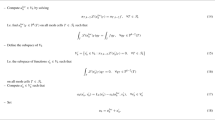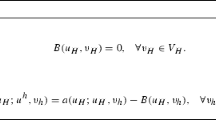Abstract
We propose an arbitrary-order discontinuous Galerkin method for second-order elliptic problem on general polygonal mesh with only one degree of freedom per element. This is achieved by locally solving a discrete least-squares over a neighboring element patch. Under a geometrical condition on the element patch, we prove an optimal a priori error estimates in the energy norm and in the \(\hbox {L}^2\) norm. The accuracy and the efficiency of the method up to order six on several polygonal meshes are illustrated by a set of benchmark problems.









Similar content being viewed by others
References
Adams, R.A., Fournier, J.J.F.: Sobolev Spaces, 2nd edn. Elsevier, Amsterdam (2003)
Antonietti, P.F., Giani, S., Houston, P.: \(hp\)-version composite discontinuous Galerkin methods for elliptic problems on complicated domains. SIAM J. Sci. Comput. 35, A1417–A1439 (2013)
Arnold, D.N.: An interior penalty finite element method with discontinuous elements. SIAM J. Numer. Anal. 19, 742–760 (1982)
Arnold, D.N., Brezzi, F., Cockburn, B., Marini, L.D.: Unified analysis of discontinuous Galerkin methods for elliptic problems. SIAM J. Numer. Anal. 39, 1749–1779 (2002)
Banks, J., Hagstrom, T.: On Galerkin difference methods. J. Comput. Phys. 313, 310–327 (2016)
Barth, T.J., Larson, M.G.: A posteriori error estimates for higher order Godunov finite volume methods on unstructured meshes. Finite volumes for complex applications, III (Porquerolles, 2002), pp. 27–49. Hermes Sci. Publ, Paris (2002)
Bassi, F., Botti, L., Colombo, A., Rebay, S.: Agglomeration-based discontinuous galerkin discretization of Euler and Navier–Stokes equations. Comput. Fluids 61, 77–85 (2012)
Bassi, F., Botti, L., Colombo, A.: Agglomeration-based physical frame dG discretization: an attempt to be mesh free. Math. Models Methods Appl. Sci. 24, 1495–1539 (2014)
Brenner, S.C., Scott, L.R.: The Mathematical Theory of Finite Element Methods, vol. 15, 3rd edn. Springer, New York (2008)
Brezzi, F., Lipnikov, K., Simoncini, V.: A family of mimetic finite difference methods on polygonal and polyhedral meshes. Math. Models Methods Appl. Sci. 15, 1533–1551 (2005)
Brezzi, F., Buffa, A., Lipnikov, K.: Mimetic finite differences for elliptic problems. ESAIM Numer. Anal. 43, 277–295 (2009)
Cangiani, A., Georgoulis, E.H., Houston, P.: \(hp\)-version discontinuous Galerkin methods on polygonal and polyhedral meshes. Math. Models Methods Appl. Sci. 24, 2009–2041 (2014)
Cangiani, A., Dong, Z.N., Georgoulis, E.H., Houston, P.: hp-version discontinuous galerkin methods for advection–diffusion–reaction problems on polytopic meshes. ESAIM Math. Model. Numer. Anal. 50, 699–725 (2016)
Cangiani, A., Dong, Z.N., Georgoulis, E.H., Houston, P.: hp-Version Discontinuous Galerkin Methods on Polygonal and Polyhedral Meshes. SpringerBriefs in Mathematics. Springer, Berlin (2017)
Chen, H.T., Guo, H.L., Zhang, Z.M., Zou, Q.S.: A \({\rm C}^{0}\) linear finite element method for two fourth order eigenvalue problems. IAM J. Numer. Anal. 37, 2120–2138 (2017)
Ciarlet, P.G.: The Finite Element Method for Elliptic Problems. North-Holland, Amsterdam (1978)
Clément, P.: Approximation by finite element functions using local regularization. RAIRO Anal. Numér. 9, 77–84 (1975)
Cockburn, B., Karniadakis, G.E., Shu, C.W.: The development of discontinuous Galerkin methods. In: Newport, R.I. (ed.) Discontinuous Galerkin Methods, Lect. Notes Comput. Sci. Eng., vol. 11, pp. 3–50. Springer, Berlin (1999)
Cockburn, B., Gopalakrishnan, J., Lazarov, R.: Unified hybridization of discontinuous Galerkin, mixed, and continuous Galerkin methods for second order elliptic problems. SIAM J. Numer. Anal. 47, 1319–1365 (2009)
da Veiga, L.B., Lipnikov, K., Manzini, G.: The Mimetic Finite Difference Method for Elliptic Problems, MS&A. Modeling, Simulation and Applications, vol. 11. Springer, Cham (2014)
Dekel, S., Leviatan, D.: The Bramble–Hilbert lemma for convex domains. SIAM J. Math. Anal. 35, 1203–1212 (2004)
Di Pierto, D.A., Ern, A.: Mathematical Aspects of Discontinuous Galerkin Methods, vol. 69. Springer, Berlin (2012)
Di Pierto, D.A., Ern, A., Lemaire, S.: An arbitrary-order and compact-stencil discretization of diffusion on general meshes based on local reconstruction operators. Comput. Methods Appl. Math. 14, 461–472 (2014)
Dupont, T., Scott, L.R.: Polynomial approximation of functions in Sobolev spaces. Math. Comput. 34, 441–463 (1980)
Georgoulis, E., Pryer, T.: Recovered finite element methods. Comput. Methods Appl. Mech. Eng. 332, 303–324 (2018)
Geuzaine, C., Remacle, J.F.: Gmsh: a 3-D finite element mesh generator with built-in pre- and post-processing facilities. Int. J. Numer. Methods Eng. 79, 1309–1331 (2009)
Grisvard, P.: Elliptic Problems in Nonsmooth Domains. Pitman, Boston (1985)
Guo, H.L., Zhang, Z.M., Zou, Q.S.: A \({\rm C}^{0}\) linear finite element method for biharmonic problems. J. Sci. Comput. 74, 1397–1422 (2018)
Hampshire, J.K., TBH, V., CH, C.: Three node triangular bending elements with one degree of freedom per node. Eng. Comput. 9(1), 49–62 (1992)
Hesthaven, J.S., Warburton, T.: Nodal Discontinuous Galerkin Methods: Algorithms, Analysis, and Applications, p. 233. Springer, Berlin (2008)
Larsson, K., Larson, M.G.: Continuous piecewise linear finite elements for the Kirchhoff–Love plate equation. Numer. Math. 121, 65–97 (2012)
Li, R., Ming, P.B., Tang, F.Y.: An efficient high order heterogeneous multiscale method for elliptic problems. Multiscale Model. Simul. 10, 259–283 (2012)
Li, R., Ming, P.B., Sun, Z.Y., Yang, F.Y., Yang, Z.J.: A discontinuous Galerkin method by patch reconstruction for biharmonic problem. J. Comput. Math. 37, 561–578 (2019a)
Li, R., Sun, Z.Y., Yang, F.Y.: Solving eigenvalue problems in a discontinuous Galerkin approximate space by patch reconstruction (2019b). arXiv:1901.01803
Li, R., Sun, Z.Y., Yang, F.Y., Yang, Z.J.: A finite element method by patch reconstruction for the Stokes problem using mixed formulations. J. Comput. Appl. Math. 353, 1–20 (2019c)
Lipnikov, K., Vassilev, D., Yotov, I.: Discontinuous Galerkin and mimetic finite difference methods for coupled Stokes–Darcy flows on polygonal and polyhedral grids. Numer. Math. 126, 1–40 (2013)
Mozolevski, I., Süli, E.: A priori error analysis for the \(hp\)-version of the discontinuous Galerkin finite element method for the biharmonic equation. Comput. Methods Appl. Math. 3, 596–607 (2003)
Mu, L., Wang, J.P., Wang, Y.Q., Ye, X.: Interior penalty discontinuous Galerkin method on very general polygonal and polyhedral meshes. J. Comput. Appl. Math. 255, 432–440 (2014)
Narcowich, F.J., Ward, J.D., Wendland, H.: Sobolev bounds on functions with scattered zeros, with applications to radial basis function surface fitting. Math. Comput. 74, 743–763 (2005)
Nay, R.A., Utku, S.: An alternative for the finite element method. In: Variational Methods in Engineering, vol. 1. University of Southampton (1972)
Oñate, E., Cervera, M.: Derivation of thin plate bending elements with one degree of freedom per node: a simple three node triangle. Eng. Comput. 10, 543–561 (1993)
Phaal, R., Calladine, C.R.: A simple class of finite elements for plate and shell problems. II: an element for thin shells, with only translational degrees of freedom. Int. J. Numer. Methods Eng. 35, 979–996 (1992)
Reed, W.H., Hill, T.R.: Triangular Mesh Methods for the Neutron Transport Equation. Tech. Report LA-UR-73-479, Los Alamos Scientific Laboratory (1973)
Reichel, L.: On polynomial approximation in the uniform norm by the discrete least squares method. BIT 26, 349–368 (1986)
Sukumar, N., Tabarraei, A.: Conforming polygonal finite elements. Int. J. Numer. Methods Eng. 61, 2045–2066 (2004)
Sullivan, D.O.: Exploring spatial process dynamics using irregular cellular automaton models. Geogr. Anal. 33, 1–18 (2001)
Venkatakrishnan, V.: Convergence to steady state solutions of the Euler equations on unstructured grids with limiters. J. Comput. Phys. 118, 120–130 (1995)
Wendland, H.: Scattered Data Approximation. Cambridge Univeristy Press, Cambridge (2005)
Wilhelmsen, D.: A Markov inequality in several dimensions. J. Approx. Theory 11, 216–220 (1974)
Wirasaet, D., Kubatko, E.J., Michoski, C.E., Tanaka, S., Westerink, J.J., Dawson, C.: Discontinuous Galerkin methods with nodal and hybrid modal/nodal triangular, quadrilateral, and polygonal elements for nonlinear shallow water flow. Comput. Methods Appl. Mech. Eng. 270, 113–149 (2014)
Yamakawa, S., Shimada, K.: Converting a tetrahedral mesh to a prism-tetrahedral hybrid mesh for FEM accuracy and efficiency. Int. J. Numer. Methods Eng. 80, 2099–2129 (2009)
Acknowledgements
The authors would like to thank Dr. Fengyang Tang for his help in the earlier stage of the present work, and the authors would like to thank the anonymous referees for the constructive comments that improve the paper. Funding was provided by National Natural Science Foundation of China (Grant Nos. 11425106, 91630313, 91630313, 11671312)
Author information
Authors and Affiliations
Corresponding author
Additional information
Publisher's Note
Springer Nature remains neutral with regard to jurisdictional claims in published maps and institutional affiliations.
Rights and permissions
About this article
Cite this article
Li, R., Ming, P., Sun, Z. et al. An Arbitrary-Order Discontinuous Galerkin Method with One Unknown Per Element. J Sci Comput 80, 268–288 (2019). https://doi.org/10.1007/s10915-019-00937-y
Received:
Revised:
Accepted:
Published:
Issue Date:
DOI: https://doi.org/10.1007/s10915-019-00937-y




